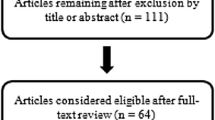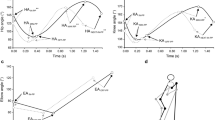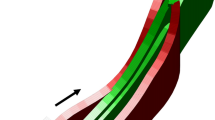Abstract
Wide skis are the most popular ski sold in the United States and are skied routinely in all types of terrain, especially by young skiers. This study investigated the influence of slalom (SL, 64 mm underfoot width) and wide skis (WS, 97.7 mm underfoot width) on perceptual responses, timed performance, edge inclination angles, and EMG in young alpine ski racers. Thirteen subjects, mean age 12.8 ± 0.5 years, completed one run on each of two courses which were set to approximate the different turning radii of each ski. They completed a Likert-type questionnaire to assess components of self-efficacy after each run. EMG activity was recorded on the gluteus medius (GM), vastus lateralis, tibialis anterior and peroneus longus (PL). Perceptions of confidence, aggressiveness, speed, and skiing on line were significantly greater, by about 31%, for SL than WS regardless of course. Turn times were significantly less by 4% for SL than WS, peak edge inclination angle was 7% greater for SL than WS, and PL activity was 40% less for SL compared to WS. Young racers are developing skills to improve their racing techniques and are still forming technique strategies to deal with the many factors present in skiing which may disrupt learning progressions. With lower perceptual and performance responses on WS, young ski racers who ski on groomed snow with WS could be interfering with the adaptation of fundamental racing technique at a critical time in their development.



Similar content being viewed by others
References
Bandura A. The explanatory and predictive scope of self-efficacy theory. J Soc Clin Psychol. 1986;4(3):359–73. https://doi.org/10.1521/jscp.1986.4.3.359.
Bernstein NA. The co-ordination and regulation of movements. Oxford: Pergamon Press; 1967.
Caňal-Bruland R, van der Kamp J. Action goals influence action specific perception. Psychon B Rev. 2009;16:1100–5. https://doi.org/10.3758/pbr.16.6.1100.
Davids K, Renshaw I, Pinder R, Araujo D, Vilar L. Principles of motor learning in ecological dynamics: a comment on functions of learning and the acquisition of motor skills (with reference to sport). Open Sports Sci J. 2012;5(1):113–7. https://doi.org/10.2174/1875399x01205010113.
Fajen B, Riley M, Turvey M. Information, affordances and the control of action in sport. Int J Sport Psychol. 2008;40(1):79–107.
Feltz DL. Self-confidence and sports performance. Exerc Sport Sci Rev. 1988;16:423–57. https://doi.org/10.1249/00003677-198800160-00016.
Hintermeister RA, O’Connor DD, Dillman CJ, Suplizio CL, Lange GW, Steadman JR. Muscle activity in slalom and giant slalom skiing. MSSE. 1995;27(3):315–22. https://doi.org/10.1249/00005768-199503000-00005.
Kipp R, Reid R, Gilgien M, Haugen P, Smith G. Relative contributions of leg angles to ski edging during a slalom ski turn. In: Müller E, Lindinger S, Stöggl T, Pfusterschmied J, editors. Science and Skiing IV. Finland: University of Jyväskylä; 2010. p. 129.
Kipp RW, Seifert JG, Nolting J, Keller LL. The influence of slalom gate length on performance, acceleration, and perception in young alpine ski racers. In: Müller E, Lindinger S, Stöggl T, Pfusterschmied J, editors. Science and Skiing V. UK: Meyer & Meyer Publishers; 2014. p. 102.
Lin C-H, Fisher BE, Wu AD, Ko YA, Lee LY, Winstein CJ. Neural correlate of the contextual interference effect of motor learning: a kinematic analysis. J Mot Behav. 2009;41(3):232–42. https://doi.org/10.3200/jmbr.41.3.232-242.
Lloyd RS, Oliver JL. The youth physical development model: a new approach to long-term athletic development. Strength Cond J. 2012;34(3):61–72. https://doi.org/10.1519/ssc.0b013e31825760ea.
Martin JJ, Gill DL. The relationships among competitive orientation, sport-confidence, self-efficacy, anxiety, and performance. JSEP. 1991;13(2):149–59. https://doi.org/10.1123/jsep.13.2.149.
Martínez A, Jahnel R, Buchecker M, Snyder C, Brunauer R, Stöggl T. Development of an automatic alpine skiing turn detection algorithm based on a simple sensor setup. Sensors. 2019;19(4):12. https://doi.org/10.3390/s19040902.
Martínez A, Brunauer R, Venek V, Snyder C, Jahnel R, Buchecker M, Stöggl T. Development and validation of a gyroscope-based turn detection algorithm for alpine skiing in the field. Fspor. 2019. https://doi.org/10.3389/fspor.2019.00018.
Müller E, Schwameder H. Biomechanical aspects of new techniques in alpine skiing and ski-jumping. JSS. 2003;21(9):679–92. https://doi.org/10.1080/0264041031000140284.
Pisot R, Kipp R, Supej M. Skiing is a game: pedagogical and biomechanical foundations of learning to ski. Koper, Slovenia: Univerzitetna Založba Annales; 2010.
Psychountaki M, Zervas Y. Competitive worries, sport confidence, and performance ratings for young swimmers. Percept Mot Ski. 2000;91(1):87–94. https://doi.org/10.2466/pms.2000.91.1.87.
Rainoldi A, Melchiorri G, Caruso I. A method for positioning electrodes during surface EMG recordings in lower limb muscles. J Neurosci Methods. 2004;134(1):37–43. https://doi.org/10.1016/j.jneumeth.2003.10.014.
Rauk E, Quigley B, Kipp RW, Seifert JG, Nolting J, Keller LL. The influence of slope angle and gate length during slalom training in developing alping ski racers. In: Müller E, Lindinger S, Stöggl T, Pfusterschmied J, editors. Science and Skiing V. UK: Meyer & Meyer Publishers; 2014. p. 128.
Ryckman RM, Robbins MA, Thornton B, Cantrell P. Development and validation of a physical self-efficacy scale. J Pers Soc Psychol. 1982;42:891–900. https://doi.org/10.1037/0022-3514.42.5.891.
Schmidt RA. A schema theory of discrete motor skill learning. Psychol Rev. 1975;82:225–60. https://doi.org/10.1037/h0076770.
Seifert JG, Nunnikhoven H, Snyder C, Kipp RW. Does ski width influence muscle action in an elite skier? A case study. Müller E, Kröll J, Lindinger S, Pfusterschmied J, Stöggl T, editors. Science and Skiing VII. UK: Meyer & Meyer Publishers. 2018. pp. 174–179.
Seifert JG, Olvermann M, Kipp RW. Muscular responses to ski width when skiing on groomed and powder snow conditions. In: Karczewska-Lindinger M, Hakkarainen A, Linnamo V, Lindinger S, editors. Science and Skiing VIII. Finland: University of Jyväskylä; 2020. pp. 100–107.
Snowsports Industries America. SIA research industry insights study. 2017. http://www.snowsports.org/sia-research-industry-insights-study/. Accessed 10 Aug 2018.
Snyder C, Martínez A, Brunauer R, Stöggl T. Validation of a wearable system for edge angle estimation during alpine skiing. In: Karczewska-Lindinger M, Hakkarainen A, Linnamo V, Lindinger S, editors. Science and Skiing VIII. Vuokatti Sports Technology Unit of the Faculty of Sport and Health Sciences of the University of Jyväskylä. 2020. pp. 64–72.
Spörri J, Kröll J, Gilgien M, Müller E. How to prevent injuries in alpine ski racing: what do we know and where do we go from here? Sports Med. 2017;47(4):599–614. https://doi.org/10.1007/s40279-016-0601-2.
Supej M, Holmberg HC. Recent kinematic and kinetic advances in Olympic alpine skiing: Pyeongchang and beyond. Front Physiol. 2019. https://doi.org/10.3389/fphys.2019:00111.
United States Ski and Snowboard Association. SkillsQuest. 2020. http://usskiandsnowboard.org/sport-programs/skillsquest/. Accessed 29 Aug 2018.
Vaverka F, Vodickova S. Laterality of the lower limbs and carving turn. Biol Sport. 2010;27:129–34. https://doi.org/10.5604/20831862.913080.
Weinberg RS, Gould D. Foundations of sport and exercise psychology. 5th ed. Champaign: Human Kinetics; 2011.
Wright DL, Shea CH. Contextual dependencies in motor skills. Mem Cognit. 1991;19(4):361–70.
Zorko M, Nemec B, Babic J, Lesnik B, Supej M. The waist width of skis influences the kinematics of the knee joint in alpine skiing. JSSM. 2015;14(3):606–19.
Acknowledgements
A special thank you to the Squaw Valley | Alpine Meadows Resort and Ski Team administrators and coaches for arranging slope access and organization for this study, especially Jim Hudson, Michelle Delumyea, and Dee Byrne. Thanks also to the participants and parents for their generous donation of time.
Author information
Authors and Affiliations
Corresponding author
Ethics declarations
Conflict of interest
There are no conflicts of interest.
Ethics approval
Approval of this project was from the Institutional Review Board.
Consent to participate
All participants and their guardians provided written informed consent.
Consent for publication
All authors give their consent to publish.
Rights and permissions
About this article
Cite this article
Nunnikhoven, H.B., Snyder, C., Kipp, R.W. et al. The Influence of Ski Type on Muscle Activity, Performance, and Self-Efficacy in Young Alpine Ski Racers. J. of SCI. IN SPORT AND EXERCISE 3, 312–319 (2021). https://doi.org/10.1007/s42978-021-00123-3
Received:
Accepted:
Published:
Issue Date:
DOI: https://doi.org/10.1007/s42978-021-00123-3




